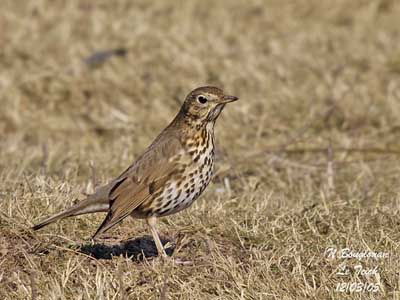
The Song Thrush
Turdus philomelos
Passeriforme Order – Turdidae Family
The sun hardly rises, and its melodious song already invades the countryside. A clear phrase, including wonderful, high and powerful notes of great musicality and repeated several times, compose this sound of surprising variety and beautiful quality. It sings tirelessly since its high perch, a tree, shrub, or wall. The high-pitched notes cross both valleys and thickets, in the early morning and often until the dusk. It is not for nothing if it is called Song Thrush!

A brief dry blow, then another, still followed by few others… The Song Thrush is here, very close, breaking the shell of a snail on its favourite stone on the roadside. Sometimes, the support changes and the bird beats the poor gastropod against a trunk. Here and there, some empty, broken, bleached shells betray the presence of this graceful bird. But if the snails remain its favourite food, it is also fond of earth worms. We have to see it, with tensed body, to draw on the flushed worm out from its hole. It draws, and still draws, until extracting it completely.
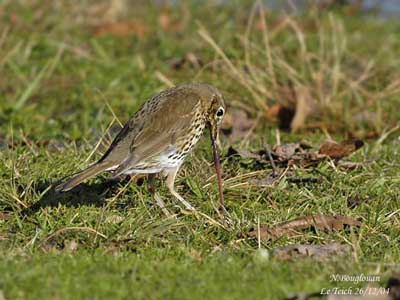
But worms and snails do not constitute all its food. It also consumes small slugs and a large variety of insects and their larvae, including ants. It catches many spiders and millipedes, but also woodlice found in the decayed wood and under the leaf litter. It likes the well ripe fruits, even slightly rotten, and rather the fallen fruits, preferring to feed on the ground. It walks with small fast steps, leaning the head from side to side in order to see its preys better, because its has lateral eyes.
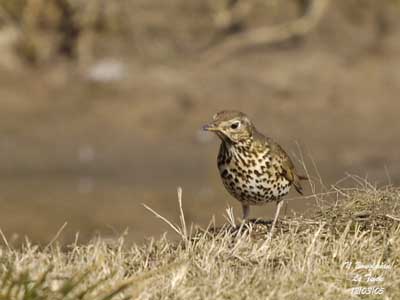
The Song Thrush over all likes the wooded areas, large parks and gardens, bushes, hedges and shrubs. Part of the population migrates southwards in winter, but according to the location, some of them are sedentary. The thrush is very sensitive to the cold weather, and if the winter becomes particularly rigorous, it remains prostrated and lifeless. At this moment, the fallen fruits hidden under the leaf litter can be very important for its survival.
The Song Thrush is uniformly brown on the upperparts. Its typical attitude with up-stretched body and raised head, show the numerous reversed heart-shaped spots which contrast with the whitish chest and flanks. Suffused buffy-coloured shades may be seen on both sides of the neck base and near the scapulars, giving more relief to the mottled areas. The fine brown head shows a pale line from the base of the bill to the upper part of the dark brown eyes. The bill is almost black, with pale yellow on the lower mandible. It appears slightly down-curved. The pale-coloured legs run quickly on the ground.
As soon as January, the male sings strongly. It is the beginning of the courtship display.
Although unpretentious, its behaviour indicates that the breeding season is starting. It turns around the female with fanned tail flatten on the ground, while it throws the head backwards with open bill. This display is precopulatory behaviour.
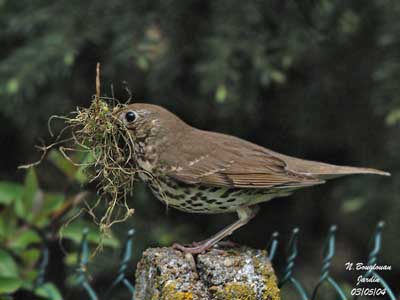
At hatching, the chicks are covered with long golden-buff down on head and back. They are fed by both adults during about two weeks, and they leave the nest at this moment.
Chicks at nest are fed with worms, cherries, snails and small slugs. After fledging, the parents still feed them during fifteen to twenty days, before they become independent. They remain hidden at the base of the bushes waiting for the adults, invisible for the predators.
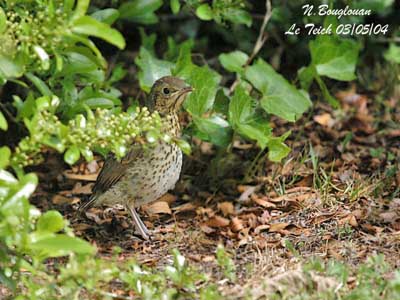
Unfortunately, this unobtrusive and shy bird has strongly suffered from heavy hunting. The chicks were removed from the nests and reared in captivity, and the adults were killed and sent to the big cities where they delicate flesh was appreciated.
The implemented measures to forbid the hunting start to give some results, and if the population is increasing little by little, the numbers are still far from those of the mid 20th century, where the Song Thrush lived so quietly, and flooded forests and countries with its melodious song.
Text and pictures by Nicole Bouglouan
Sources:
THE HANDBOOK OF BIRD IDENTIFICATION FOR EUROPE AND THE WESTERN PALEARCTIC, by Mark Beaman, Steve Madge - C.Helm - ISBN: 0713639601
THE COMPLETE BOOK OF ENGLISH BIRDS - Préface de Magnus Magnusson - Michael Cady- Rob Hume - ISBN: 0749509112
PAJAROS DE ESPANA (JL Beamonte)
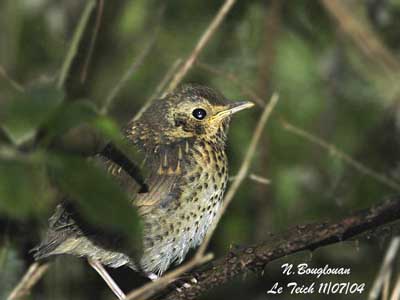
The Song Thrush’s nest is usually situated in a bush, sometimes in cavities among the stones of a structure in ruins, but it is often built in tree, near the trunk. The female builds it alone while the male sings in the nearby area, without to provide her any help.
It is a bulky cup made with dry grasses, twigs, moss, dead leaves and some lichens, mixed with mud. The interior is lined with rootlets and fine bark chips. All is maintained with saliva, in order to get a strong matter similar to cardboard.
The nest has to be finished in late March. The clutch includes between three and six pale blue glossy eggs, mottled black. The incubation lasts about 13 to 14 days, by the female alone. This species can produce two or three broods per season.
4mn 23 s
4mn 5s
3mn 16s